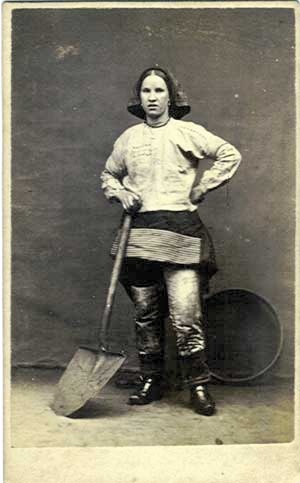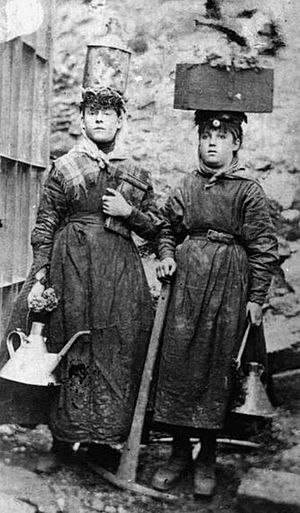Pit brow women facts for kids

Pit brow women or pit brow lasses were women who worked at coal mines in Britain. They worked above ground, not deep inside the mine. Their job was to sort coal on the "pit bank" or "brow" near the mine shaft. They picked out stones and dirt from the coal after it was brought to the surface. Many pit brow women worked in the Lancashire Coalfield area until the 1960s.
Contents
Working in Coal Mines
Life Before 1842: Working Underground
In the early days of coal mining, women and girls often worked underground. They toiled alongside men and boys in small coal pits. This was common in places like Lancashire, Yorkshire, and South Wales. For example, in 1641, a record shows Elizabeth Higginson died while working underground in Wigan. Later, in 1795, a magazine wrote about Betty Hodson, just nine years old. She worked underground with her seven-year-old brother, pulling baskets of coal for their father.
From the 1600s, it was normal for entire families to work in the mines. Coal miners, called colliers, depended on their wives and children. These family members often worked as "drawers," pulling coal. Daughters of colliers usually married other miners. As the mining industry grew, more family members found work in the pits. This led to many women working in mines, especially in south-west Lancashire during the 1800s.
The 1842 Act: A Big Change
A terrible event happened on July 4, 1838, at the Huskar Pit in Yorkshire. A sudden flood drowned 26 children, aged seven to 17, who were trying to escape. This disaster shocked the public. It led to a special investigation called a Royal Commission. This group looked into the working conditions in mines.
Before the Mines and Collieries Act 1842 was passed, women and children worked long hours underground. They often worked 11 or 12-hour shifts. Some children as young as five or six worked as "trappers." They opened and closed ventilation doors. Later, they became "hurriers," pushing coal tubs to the bottom of the mine shaft. The 1842 Act finally stopped boys under ten and all women and girls from working underground in coal mines.
After 1842: Working Above Ground
The new law stopping women from working underground caused problems for many families. It was especially hard in south-west Lancashire. Some employers secretly allowed women to keep working underground for a few years. These women would dress as men to avoid being caught. The fines for breaking the law were small, and there were few inspectors. Some women were so desperate for work that they willingly worked illegally for less pay. Children also continued to work underground in some mines. For example, in 1846, three females, one just eleven years old, died after an explosion at a mine.
Not all women who had worked underground found new jobs on the surface. Lighter surface jobs were usually for older men or men who had been injured. Some mine owners thought pits were not suitable places for women. However, other owners were happy to hire women. They knew these women were reliable and strong workers. They were also used to the miners' way of life. Male surface workers earned twice as much as the women. Women worked twelve-hour shifts, five days a week, and a shorter shift on Saturdays. Many women surface workers were found in Scotland, South Wales, and Lancashire.
What Pit Brow Women Wore
Pit brow women worked outside in the cold and dirt. They developed a special "uniform" that was practical for their tough jobs. They wore clogs on their feet. They wore trousers, which they covered with a skirt and an apron. They also wore old flannel jackets or shawls. To protect their hair from coal dust, they wore headscarves.
Their unusual but practical clothing made them stand out. People were interested in them. Pictures of pit brow women in their work clothes were sold as souvenirs. These pictures were often on carte de visite (small photos) and later on postcards. Photographers in Wigan, like Louisa Millard and Cooper, took many of these pictures. Arthur Munby, a lawyer, was very interested in women who did dirty or unusual jobs. He often visited Wigan to interview working-class women. He wrote in his diaries about their jobs, pay, and living conditions.
At the time, some people with Victorian morality were shocked by women working at mines. They thought women wearing trousers was "unfeminine" and wrong for society.
See also
- Bal maiden - women who worked in the Cornish tin mines
- Victorian dress reform


